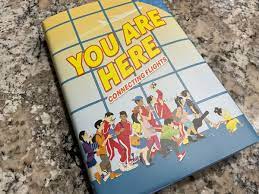Ellen Oh is a Korean American author who is co-founder of the organization We Need Diverse Books, and the editor for the collection The Flying Leçons. Her newest project, You Are Here: Connecting Flights (Allida/HarperCollins, March 7), is a poignant set of stories that take place on the same summer night in the same terminal at Chicago’s O’Hare Airport. Though each protagonist are East or Southeast Asian and 12 years old, that’s what makes them unique. from an autism-prone Korean Middle Schooler, to the Filipino Basketball player, to an ethnically diverse Chinese Jew The characters represent the individuals from The Asian American diaspora who are often not seen.
The volume’s 12 talented Asian American contributors–including Erin Entrada Kelly, Grace Lin, Linda Sue Park, Randy Ribay, and Christina Soontornvat–have co-created a text that reads more like a novel than a set of short stories; in a starred review, Kirkus calls it “compelling and nuanced.” Over video chat, we asked Ellen about the inspiration, process, and politics that led to this fabulously inventive read. The chat was edited to be more concise and clear.
What was the inspiration behind the project?
The story began by receiving an email from the Asian American blogger who was quite angry by the fact that The Flying Lessonsleft the site without the Asian American diaspora story. I’m Asian and was unaware of this! I’ve been thinking about creating a collection of Asian diaspora stories since.
You’re an incredibly prolific writer. What made you choose to tackle the subjects in this book together with an author group instead of writing a novel that you wrote on your own?
Due to the rising anti-Asian sentiment in November of and we were at the forefront of this, I was looking to connect with writers from a few authors to write this collection. Truthfully hateful and violent attitudes towards Asians were always there. This was only amplified in the aftermath of the epidemic. Every day I’ve heardthe phrase “Go back to China, go back to where you belong.” If I could have a dollar for every time I heard this, I’d be millionaire!
Due to those experiences, I became aware that this wasn’t just my personal story. It could be more effective with a wider group of contributors. One of the first emails I wrote addressed Linda Sue Park. I asked her if she’d be interested and she said, “YES, PLEASE!” It was like screaming in full caps.
It’s not an Anthology. I wanted this book to be interconnected stories in which characters are woven into and out of one another’s worlds. The story was fluid because everyone wasn’t just invested in their own stories but also in each other’s stories, too. Every writer had an the intention of weaving with other characters.
This must have been a serious collaboration. What was the process?
In the initial sessions, we discussed emails. However, as we added more more authors, the process began to get a bit cumbersome. I believe the reason was Randy Ribay who commented, “You know, this could have been done over Zoom.” The most difficult part was to convince 12 people to set up an appointment on Zoom!
When we spoke on those calls we wanted to go in-depth about the specifics. There was always two or three people not present and I took numerous notes. In reality I even recorded the calls to be able to go back and take lots of notes. It was a great idea as I was able to note a lot of aspects you’re not aware of when taking part. I created a spreadsheet with details about the names of the characters? Who’s in the group? What’s their attire? we could determine how others were using characters from other people.
There were also times when I’d jump on calls with authors with an interest in the story. I assisted them in figuring out the details and observe what I could see, since I was a part of all of the stories. I can tell you the calls were enjoyable. It was like working and having fun. The pandemic was on and so the majority of hanging out was connected to Zoom in the end.
The book is cinematic. If it ever made it to screen Who would you like for the role?
The book was offered to the publisher] based on a handful of summaries of storiesHowever, these summaries are like an animated film, where there’s an event that is the catalyst that is a ripple effect that affects all the stories. The final story then ties together all of the stories in a grand finale. It’s like the movie Crash The story has many storylines that don’t appear to be connected until you suddenly you realize how they all connect. This is what I was looking for.
In my story, I’d imagine Lee Byung-hun who is in the K-drama “Our Blues. He’s also part of Squid Games. Shin Min-a and him who’s one of my favorites actors, have a great bond! They’re ideal for the roles that Sujin’s parents play.
What is your story about how your involvement in as a co-founder of We Need Diverse Books shaped the HTML0 project and others?
As a member of my experience with the We Need Diverse Books movement I’ve discovered that the community of children’s books is an amazing place filled with caring people for our children. It’s not just about authors and illustrators. I’m talking about editors, marketers bookshop owners, librarians academics, teachers and teachers from every level. It’s a very supportive and loving community. And We need Diverse Books is a part of this. We’ve helped a lot of creators beginning with our first grantee, Angie Thomas and moving on up to the most current mentor, Amina Luqman-Dawson who won the Newbery (for her book, Freewater]. I’m extremely proud of it.
However, at the moment all of effort is at risk because of the increasing book bans targeting LGBTQ+ and BIPOC books. This is an attempt at continuing to attempt to keep the voices of marginalized groups out of the narrative of the majority, on denying us a voice by denying our voices. If you do not have a voice it’s not yours to have. It’s all about bigotry and prejudice.
There are two issues at play. One There are people who say, “Oh, that’s terrible, but that’s not what’s happening around me.” However, it’s happening all over the world! Local politics are now an issue and we must look around. The second issue is the misconception that prohibiting books can be an effective way to increase publicity. However, authors who are marginalized and banned from publishing books do not receive publicity or even placement money, and this can hurt book sales. Publishing is a business, therefore when books written by authors who are marginalized don’t sell, they cease to receive contracts. It is imperative to mobilize people right now, before the harm can be irreparably damaged.
Which person do wish is reading this book? If so, why?
The book was written for every child who’s ever felt that they don’t belong. This book states, We got you. We understand. We understand and we’re not the only ones. I’d like to see this book in all middle schools’ libraries, and especially those that have banned books. These are the places where kids will begin to feel like the world isn’t interested in them. Every single book I write, and this one in particular is intended to convey to the reader, instead, We’ll get out of this. We’ll come up with the answer, and we’ll accomplish it in tandem.















